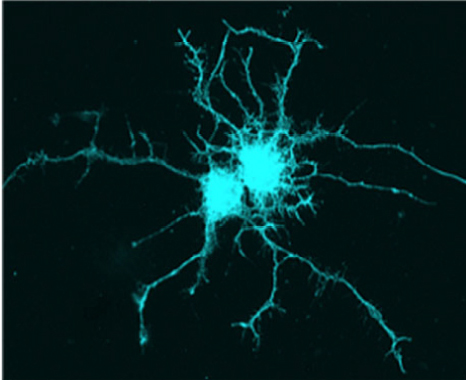
RÉCEPTEUR 5-HT6 DE LA SÉROTONINE : QUAND CHANGER DE PARTENAIRE PERMET DE CHANGER DE RÔLE
Le récepteur 5-HT6 de la sérotonine est une cible privilégiée pour le traitement des déficits cognitifs associés aux maladies neuro-développementales. Ce récepteur couplé aux protéines G interagit avec un large réseau de partenaires protéiques, ce qui lui permet d’exercer de nombreux rôles dans le développement du système nerveux central. Notre équipe a en effet mis en évidence un rôle crucial de ce récepteur dans la migration neuronale et l’initiation de la pousse neuritique grâce à son interaction avec la protéine Cyclin-Dependent kinase (Cdk)5. De façon intéressante, ces effets sont constitutifs et n’impliquent pas l’activation de la voie de signalisation canonique Gs.
Dans cette nouvelle étude, l'équipe de Philippe Marin à l'IGF met en évidence une interaction du récepteur avec la protéine GPRIN1 (G-Protein Regulated Inducer of Neurite outgrowth), qui permet au récepteur d’induire un allongement des neurites et une complexification de l’arbre dendritique, toujours de façon constitutive mais cette fois en stimulant la protéine Gs, la production d’AMP cyclique et l’activation de la protéine kinase A. Nous démontrons également que les interactions entre le récepteur et ses partenaires Cdk5 et GPRIN1 se produisent de façon séquentielle, permettant au récepteur de contrôler différents processus neuro-développementaux. Cette étude démontre à la fois une régulation allostérique complexe de l’activité du récepteur et démontre que la dynamique d’interaction entre le récepteur et ses partenaires lui permet de finement contrôler des processus neurodéveloppementaux complexes et hautement coordonnés.
Représentation schématique de l’interaction séquentielle entre le récepteur 5-HT6 et Cdk5 ou GPRIN1, et ses conséquences sur la signalisation constitutive induite par le récepteur.
L’association entre le récepteur 5-HT6 et Cdk5 résulte en la phosphorylation du récepteur sur un résidu Sérine localisé dans sa partie C-terminale (Cter).
Cette étape stimule l’initiation de la pousse neuritique de façon indépendante de l’agoniste, via une signalisation dépendante de Cdc42 (panneau de gauche).
L’association avec GPRIN1 induit le recrutement de la protéine Gs activée, et l’élongation et la complexification des neurites, par un mécanisme indépendant de l’agoniste mais impliquant la protéine kinase A (panneau de droite).
Le traitement par un agoniste inverse inhibe ces deux voies de signalisation, indiquant qu’elles sont induites par l'activité constitutive du récepteur. Nter, N-terminal.
Publication : Science signaling, Feb 11;13(618) (2020). pii: eaax9520. doi: 10.1126/scisignal.aax9520. Dynamic interactions of the 5-HT6 receptor with protein partners control dendritic tree morphogenesis. Pujol C, Dupuy V, Seveno M, Runtz L, Bockaert J, Marin P, Chaumont-Dubel S
Lien "En direct des labos" (lettre publiée par le bureau de presse du CNRS à l’attention des journalistes)
.........................................................................................................................................................................................................................................................................................................
5-HT6 SEROTONIN RECEPTOR : WHEN CHANGING PARTNER ALLOWS TO CHANGE FUNCTION
The serotonin 5-HT6 receptor has emerged as a promising target to alleviate the cognitive symptoms of neuro-developmentaldiseases.This G protein-coupled receptor can interact with a large network of protein partners, which allow for numerous roles of the receptor in the development of the central nervous system.
Our team has previously demonstrated a crucial role of the receptor in neuronal migration and the initiation of neurite outgrowth through its interaction with the cyclin-dependent kinase (Cdk)5. Interestingly, these effects are constitutive and do not involve the canonical Gs signaling pathway. In this new study, we show that the receptor can recruit GPRIN1 (G-Protein Regulated Inducer of Neurite outgrowth), and induce neurite elongation and branching. This effect involves agonist-independent stimulation of Gs activity, increase in cyclic AMP production and activation of Protein Kinase A. We also demonstrate that the interactions between the 5-HT6 receptor and Cdk5 or GPRIN1 are sequential. This study highlights the complex allosteric modulation of GPCRs by protein partners and demonstrates how dynamic interactions between GPCRs and their protein partners can control the different steps of highly coordinated cellular processes, such as dendritic tree morphogenesis.
Schematic representation of the sequential interaction between the 5-HT6R and either Cdk5 or GPRIN1 and its consequence on agonist-independent 5-HT6R–stimulated signaling.
Association of the 5-HT6R with Cdk5 results in receptor phosphorylation on a serine residue located in the receptor C-terminal (Cter) domain, a necessary step in the agonist-independent, receptor-mediated activation of Cdc42 signaling and initiation of neurite outgrowth (left), whereas the association of the receptor with GPRIN1 promotes the recruitment of activated Gs and neurite extension and branching through an agonist-independent, PKA-dependent mechanism (right).
The application of an inverse agonist inhibits both pathways, indicating that these are dependent on the receptor’s constitutive activity. Nter, N-terminal.
Publication : Science signaling, Feb 11;13(618) (2020). pii: eaax9520. doi: 10.1126/scisignal.aax9520. Dynamic interactions of the 5-HT6 receptor with protein partners control dendritic tree morphogenesis. Pujol C, Dupuy V, Seveno M, Runtz L, Bockaert J, Marin P, Chaumont-Dubel S






